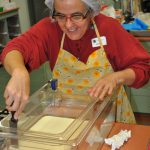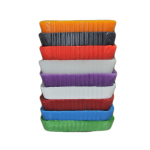When you purchase milk from a supermarket, quite often the only choice is pasteurised homogenised milk. Homogenisation and pasteurisation are two very separate processes. The law requires all milk sold in Australia to be pasteurised milk; it is illegal to sell non-pasteurised or raw milk. Homogenisation is optional as long as it is declared on the label of the bottle or carton.
If you want to make cheese, you have a choice of using either homogenised or non-homogenised milk. Fifty years ago the only options were raw or pasteurised milk; homogenised milk was not readily available. Now that the situation has reversed, it is a little harder to find non-homogenised milk, but most states in Australia now have several dairy farmers that are now turning the milk from their own cows into pasteurised but not homogenised milk. I use only non-homogenised milk at the Intensive Cheesemaking and Intensive Yoghurt Making courses.
So, which milk should you choose to make cheese?
The answer is non-homogenised milk. Why? Let’s start with an explanation of why milk is homogenised. Homogenisation came about because the public wanted the cream evenly distributed through the milk as opposed to having the cream layer at the top, where the bottle or carton had to be shaken before being poured. A secondary effect of homogenisation is that it generally lasts a few days longer than non-homogenised milk. Initially homogenised milk was met with scepticism but now it is readily accepted.
Milk is homogenised by passing it through very narrow openings under very extreme pressure. These openings are called homogeniser valves. These valves shatter the fat and proteins in the milk into billions of much tinier pieces. The cream can no longer rise to the surface and is evenly spread through the milk. The fat globules being broken up does not affect the cheese at all. The flow on effect for cheesemaking is that the very high pressure of homogenisation also breaks up the proteins into much smaller pieces. The proteins are needed in their “whole form” to turn the milk into a curd when the rennet is added. The curd does not form properly. Homogenised milk will still form a curd but it is a very weak curd and the resulting cheese is much lower quality. It is for this reason that commercial cheese manufacturers the world over do not use homogenised milk to make cheese.
There are a few minor exceptions where you can use homogenised milk to make cheese. Both homogenised and non-homogenised milk can be used to make Ricotta. Homogenised milk can also be used to make gourmet feta because it requires a soft curd.
So if you want to make good cheese, use non-homogenised milk. If you want milk with a full flavour and lots of body use non-homogenised milk. Don’t let anyone tell you otherwise.



